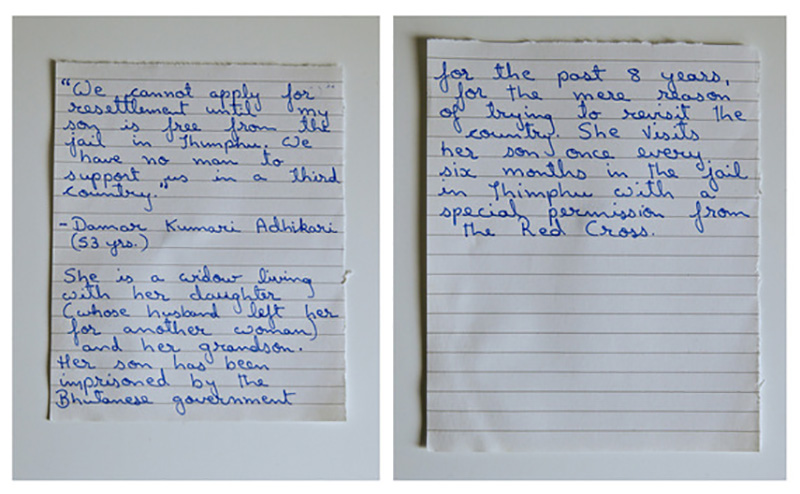Beldangi II, Damak, Nepal: The issue about Bhutanese refugees living in UNHCR camps in eastern Nepal has been making rounds in certain publications for the past few years. These refugees have been living in bamboo huts for over two decades, ever since the Bhutanese government exiled them after the Bhutanese Citizenship Act of 1985.
According to past records, the initial traces of the people of Nepalese origin in Bhutan were found in the early 1600's when Newari craftsmen were invited to Bhutan to build a silver stupa. Since most Bhutanese were farmers, the government invited skilled contractors from Nepal in the late 19th century to work for them. The Nepalese community then grew in numbers and inhabited in the desolate parts of southern Bhutan.
Post the 1985 Citizenship Act, Bhutan felt threatened and introduced the "One Nation One People" policy to preserve their cultural identity. Of the many laws legislated, one was to cease the teachings of Nepali language at school and reinforce Dzongkha as the national language.
An estimated 100,000 Bhutanese of Nepali origin fled from Bhutan and took asylum in seven different camps in Eastern Nepal between 1991 and 1993. This figure obviously multiplied over the years. Since early 2008, over 100,000 people have been referred for resettlement from Nepal to third countries.
The above mentioned are mere facts, but I want to portray the other side of the story. When I spent time with these people, I learnt their perspective and what they felt about being called refugees. They yearn to seek their identity.
I was exposed to the reality of these people who have been living in a limbo; where the old are still hoping to repatriate and the young are looking forward to their lives in a new country. Most families are separated due this dichotomy. In most cases it is the submissive mothers who suffer, as they have to choose between their children and husbands.
![2015-06-20-1434773816-3061124-MJ2014BhutaneseRefugeesinNepal013.jpg]()
![2015-06-20-1434773871-2977619-MJ2014BhutaneseRefugeesinNepal011.jpg]()
This woman lives with her husband at the camp. Her kids have already resettled in the USA. Her husband is still hoping for repatriation and refuses to resettle in a third country.
![2015-06-20-1434774314-5226155-201506191434709377781337Untitled3thumb.jpg]()
![2015-06-20-1434774365-8907414-2015061914347094428315070Untitled4thumb.jpg]()
![2015-06-20-1434774479-8040056-MJ2014BhutaneseRefugeesinNepal009c.jpg]()
![2015-06-20-1434774538-4310526-MJ2014BhutaneseRefugeesinNepal014.jpg]()
![2015-06-20-1434774593-8039898-2015061914347095652982022Untitled6thumb.jpg]()
![2015-06-20-1434774655-2556261-MJ2014BhutaneseRefugeesinNepal014a.jpg]()
![2015-06-20-1434774717-6570616-2015061914347096673230720Untitled2thumb.jpg]()
![2015-06-20-1434774818-3680084-MJ2014BhutaneseRefugeesinNepal002.jpg]()
![2015-06-20-1434774923-2034172-MJ2014BhutaneseRefugeesinNepal012.jpg]()
![]() Like Us On Facebook |
Like Us On Facebook |
![]() Follow Us On Twitter |
Follow Us On Twitter |
![]() Contact HuffPost India
Contact HuffPost India
According to past records, the initial traces of the people of Nepalese origin in Bhutan were found in the early 1600's when Newari craftsmen were invited to Bhutan to build a silver stupa. Since most Bhutanese were farmers, the government invited skilled contractors from Nepal in the late 19th century to work for them. The Nepalese community then grew in numbers and inhabited in the desolate parts of southern Bhutan.
Post the 1985 Citizenship Act, Bhutan felt threatened and introduced the "One Nation One People" policy to preserve their cultural identity. Of the many laws legislated, one was to cease the teachings of Nepali language at school and reinforce Dzongkha as the national language.
An estimated 100,000 Bhutanese of Nepali origin fled from Bhutan and took asylum in seven different camps in Eastern Nepal between 1991 and 1993. This figure obviously multiplied over the years. Since early 2008, over 100,000 people have been referred for resettlement from Nepal to third countries.
The above mentioned are mere facts, but I want to portray the other side of the story. When I spent time with these people, I learnt their perspective and what they felt about being called refugees. They yearn to seek their identity.
I was exposed to the reality of these people who have been living in a limbo; where the old are still hoping to repatriate and the young are looking forward to their lives in a new country. Most families are separated due this dichotomy. In most cases it is the submissive mothers who suffer, as they have to choose between their children and husbands.


This woman lives with her husband at the camp. Her kids have already resettled in the USA. Her husband is still hoping for repatriation and refuses to resettle in a third country.









 Like Us On Facebook |
Like Us On Facebook |  Follow Us On Twitter |
Follow Us On Twitter |